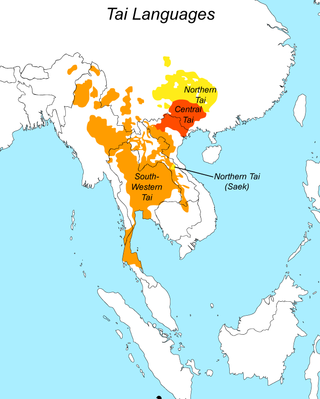
Back لغة آهوم Arabic আহোম ভাষা Assamese Idioma ahom AST আহোম ভাষা Bengali/Bangla Ahomeg Breton Ahom (Sprache) German Idioma ahom Spanish Ahom (langue) French Lingua ahom Galician अहोम भाषा Hindi
| Ahom | |
|---|---|
| Tai-Ahom[1] | |
| khwám tái ahüm(𑜁𑜪𑜨 𑜄𑜩 𑜒𑜑𑜪𑜨) | |
 The word "Ahom" in Ahom script | |
| Native to | India |
| Region | Assam |
| Ethnicity | Ahom people |
| Extinct | 18th or 19th century AD[2] used in religious chants and literary materials |
| Revival | Teaching under educational institutions such as Dibrugarh University and AHSEC[3] |
Kra–Dai
| |
| Ahom script | |
| Language codes | |
| ISO 639-3 | aho |
| Glottolog | ahom1240 |
 Tai languages Ahom language belongs to Southwestern Tai in north east India | |
 Ahom is classified as Extinct language by the UNESCO Atlas of the World's Languages in Danger[4] | |
Ahom or Tai-Ahom[1] (Ahom:𑜁𑜪𑜨 𑜄𑜩 𑜒𑜑𑜪𑜨 or 𑜁𑜨𑜉𑜫 𑜄𑜩 𑜒𑜑𑜪𑜨; khwám tái ahüm) is a dormant,[5] Southwestern Tai language formerly spoken by the Ahom people. It's currently undergoing a revival and mainly used in religious and educational purposes.[6] Ahom language was the state language of Ahom kingdom. It was relatively free of both Mon-Khmer and Indo-Aryan influences and has a written tradition dating back to the 13th century.[citation needed]
The Ahom people established the Ahom kingdom and ruled parts of the Brahmaputra river valley in the present day Indian state of Assam between the 13th and the 18th centuries. The language was the court language of the kingdom, until it began to be replaced by the Assamese language in the 17th century. Since the early 18th century, there have been no native speakers of the language, though extensive manuscripts in the language still exist today. The tonal system of the language is entirely lost. The language was only partially known by a small group of traditional priests of the Ahom religion, and it was being used only for ceremonial or ritualistic purposes.
There has been efforts to revive the language in recent times. A reconstructed version is taught in various educational institutions in Assam by AHSEC and Dibrugarh University.[7][3]
- ^ a b "Ahom". LINGUIST List. Archived from the original on 18 September 2012. Retrieved 23 December 2024.
- ^ Ahom at Ethnologue (18th ed., 2015) (subscription required)
- ^ a b "Centre for Studies in Languages - Dibrugarh University". dibru.ac.in.
- ^ Moseley, Christopher; Nicolas, Alexander, eds. (2010). Atlas of the World's Languages in Danger (PDF) (3rd ed.). Paris: UNESCO. pp. 43–47. ISBN 978-92-3-104096-2. Archived from the original on 23 July 2022.
- ^ "Linguists and historians are generally united in the view that the Ahom language has been dead for about two hundred years, and that all Ahom use Assamese as their mother tongue." (Terwiel 1996:283)
- ^ (Marwah 2020:76)
- ^ "Assam Higher Secondary Education Council official Notification".